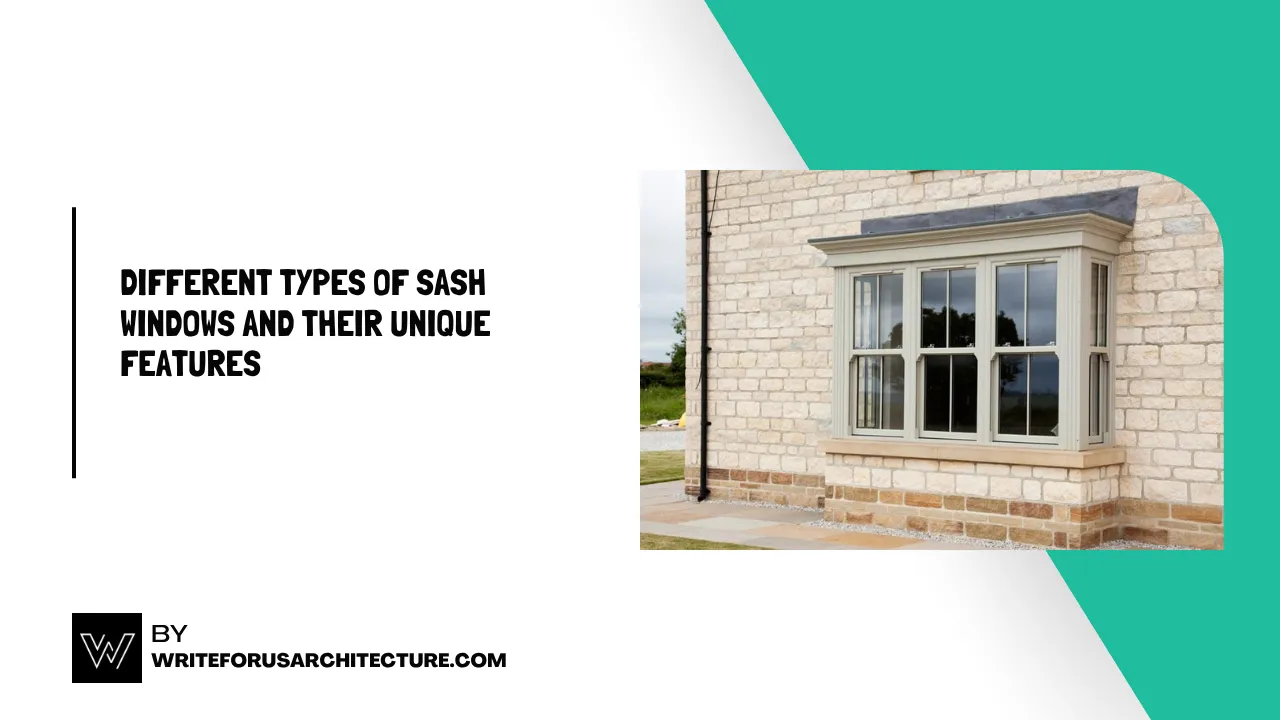Sash windows have been an integral part of home design for centuries. Their adjustable panes made it easy to regulate airflow before modern HVAC systems. Today, many classic sash window styles remain popular choices known for timeless visual elegance paired with practical functionality.
There are a wide range of sash windows, each with distinctive mechanisms, customization options, and ideal installation settings to consider.
By understanding all the sash window types and their unique advantages, homeowners can make informed decisions when replacement projects arise.
Know About Sash Windows
Sash windows are those with movable glazed pane sections that slide or open on a frame. Historically sash windows offered ventilation control using individual window panes set in two columns of horizontal or vertical sashes.
Common sash window materials include wood, uPVC, aluminum, and fiberglass chosen for durability, energy efficiency, aesthetic quality, and load-bearing strength. Contemporary sash windows often have double or triple glazing for better insulation as well.
Advantages of Sash Windows
Sash windows offer homeowners numerous advantages over other window styles. They promise long-lasting operation despite changing environmental factors.
Ventilation Control
Sash windows allow precision airflow regulation, impossible with fixed windows. Tilting upper or lower sashes incrementally suits cooling or thermal regulation needs in any season. Sash windows hand occupants total control over indoor comfort levels using natural convection and cross breezes to minimize energy expenditures.
Aesthetics
Sash windows deliver timeless beauty with tall elegant rails and stiles flanking classic rectangular lines or optional custom arched builds. Decorative muntins separating multiple divided window panes have graced historical builds for centuries. Contemporary sash windows emulate the most attractive heritage designs of previous eras.
Custom Craftsmanship
Sash windows are produced in standard dimensions yet you can ask your sash window supplier to modify it into one-off specialty shapes like circular or custom sizes matching non-standard openings. This tailored approach created windows scaled in perfect symmetry with the overall home facades.
Sustainability
Wood sash windows from responsibly harvested lumber suppliers represent an excellent green construction choice. Unlike disposable vinyl frames, wood sash windows are repairable and durable for generations, not landfill waste. Proper care ensures longevity while retaining natural beauty and carbon trapping mass timber storage capacities.
Ultimate Flexibility
Sash windows endure where other designs fail by flexing not fighting external forces over a building’s lifetime. Perimeter sealants and sliding mechanisms readily adapt to subtle foundation shifts inevitable across decades. This flexibility ensures smooth operation loosening then tightening back up seasonally between temperature extremes.
Different Types of Sash Windows
Single-Hung Sash Windows
Single-hung sash windows have an upper and lower pane or sash in a frame. The bottom sash slides up behind the typically fixed top pane allowing partial or full opening.
These windows come with several benefits which include easy lower sash cleaning by lowering from inside versus difficult external upstairs access. Their simple mechanical design also makes single-hung sash operation smooth and reliable over decades.
Single-hung sash widths span slimmer profiles to near floor-to-ceiling sizes. Their versatile styling suits traditional facades for quaint character or sleek modern high-rises desiring ample light over maximum viewscape visibility.
Double-Hung Sash Windows
Double-hung sash windows feature upper and lower sashes mobile on vertical tracks so both slide open. This improves ventilation control through dual direction and location options by lifting one or both window sash components as needed.
Double-hung sash windows encourage convective airflow via bottom-to-top convection science principles. Cooler breezes enter lower pane openings, rise warming through the room, then hot air exhausts from higher located upper sash vents.
The dual sashes also simplify safe external cleaning access to both outside upper and lower glass pane exteriors when tilted inward on hinges. Versatile styles like double-hung sashes work excellently installed alone or combined in wall segments.
Sliding Sash Windows
Sliding sash windows consist of two sashes positioned horizontally and designed to overlap when shut. One or both glazed panes slide sideways left or right along tracks to open side-by-side.
They conserve interior floorspace without extended sash pathways blocking furniture. Their overlapping divided light slats also stylistically replicate traditional cottage aesthetics when fully closed.
However, sliding sashes lack hinged inward tilting for simplified cleaning access to exterior glass panes. Cooling cross breezes also blow parallel to occupants instead of circulation entering and exiting spaces vertically.
Casement Sash Windows
Casement sash windows have side hinged frames enabling the entire one-piece pane and sash to swing outward like doors. Rotating casement window hinge directions can be lefthand, righthand, or bilateral opening.
Some benefits of these window type over sliding sash options are excellent sealing and weather resistance when fully closed against elements in storm season. Hinged swinging casements also direct welcome breezes inward across occupants unlike mere side-to-side airflow.
Casement style sash windows do have the potential for damaged rotated panes in high traffic zones. Extended crank handles can also become obstacles near walkways when left open for ventilation.
Box Sash Windows
Box sash windows feature a classic divided light grid pattern with multiple individual panes in fixed sashes. Box sashes are common in preserved heritage homes built centuries ago yet still popular in contemporary builds wanting authentic charm.
Historically, slim wood muntins separating the small multiple panes provided structural support in the absence of modern strengthened glass production methods. Today box sash muntins visually emulate delicate grids through ironwork pinned between insulating glass layers or clip-in grilles adhered without obscuring views.
Regular perimeter caulking inspections ensure moisture isn’t penetrating unseen behind grids causing hidden damages in older box sash bones. Seek repair specialists at the first sight of paint bubbles signaling potential leaks in need of sealing.
Spring-Loaded Sash Windows
Spring-loaded sash windows utilize compression spirals or coiled springs along the window jamb to counterbalance sash weights sliding up and down. The spring-force balance enables easy fingertip raising or lowering within adjustable tracks.
Spring-loaded sash windows are common in European countries like Germany while rarer in the United States. Their smooth elegant operation stays reliable for decades when properly installed against insulated weatherstrip seals preventing air leaks.
Homeowners may choose spring-loaded sash windows where larger opening dimensions require the assistive lift mechanisms for effortless updater access. Specialty shapes like circular windows also benefit from tension mounted counterweights scowling heavy panes.
Custom and Specialty Sash Windows
Many window dealers offer custom sash window consultation for homes requiring non-standard dimensions or specialty shapes like circular, curved bay, arched transom, or intricate Georgian style grid patterns.
Measuring unusual openings then ordering these specialty sash windows purpose-built to exact room specs guarantees excellent fit, finish, and performance. Custom building specialty sash windows does add cost over generic units but the precise installations reward homeowners with eye-catching focal points elevating interior spaces beautifully.
Conclusion
Many sash window varieties with different operational mechanisms, divided light arrangements, and custom special ordering options exist for discerning homeowners to consider.
Make sure you measure your openings, evaluate ventilation, lighting needs, and prioritize aesthetic vision when selecting ideal sash windows for your next home improvement project. Consider all the unique features and specialized offerings available to make an informed decision suited to personal needs and tastes.
Also Read:
IT Consulting for Business: When It’s Time to Call in the Pros – and What You’ll Actually Get

